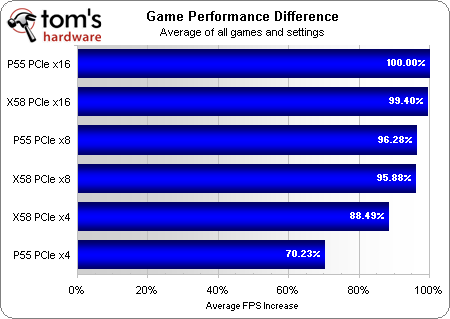PCI Express And CrossFire Scaling: Is P55 Good Enough?
PCIe Scaling Analysis
In a perfect world, the P55 and X58 platforms would have identical performance with a single graphics card in x16 mode. The P55 Express does have the theoretical performance boost of an on-die PCIe controller, though a previous examination has shown that this advantage will likely remain only a theory for quite a while. A statistic that more than eliminates the small x16-mode difference we’ve measured is that, relative to competing products, the X58 motherboard performed slightly worse in its earlier review than the P55 motherboard did in its review.

Taking board-specific performance differences into consideration, the only noteworthy changes are a minor performance loss of around 4% when moving from PCIe 2.0 x16 to x8 transfers, a moderate loss of around 11% when moving from x16 to x4 mode using the X58’s four “left-over” PCIe 2.0 lanes, and a huge 30% performance loss when using four 2.5 GT/s lanes from the P55 Express PCH.
A difference of 4% might not make or break your gaming experience, but it can be huge in a performance shootout, such as our recent System Builder Marathon (SBM). Yet, there is one more variable to add, since those machines used CrossFire technology. Curious to find out how this 4% difference could affect multi-card systems, we began testing dual-GPU and triple-GPU CrossFire/CrossFireX configurations.
Get Tom's Hardware's best news and in-depth reviews, straight to your inbox.
Current page: PCIe Scaling Analysis
Prev Page PCIe Scaling Results: Clear Sky And World In Conflict Next Page CrossFire Scaling Results: 3DMark And Crysis-
gilbertfh I just ordered myself an ASUS P7P55D-Pro and didn't understand the difference... If I spent $1200 on video cards to go in this bad boy expecting it to test at higher performance that I will never be able to see by the naked eye it may have been a bigger deal(but it isn't).Reply -
gkay09 It is pretty logical to go the X58 route if you are planning for more than 2 cards...Reply
Only 2x HD 5970s would have significant bottleneck with x8x8 config of the P55...for rest of the cards, the x8x8 still would suffice... -
jsc For most of us, it looks like the P55 is the way to go for a gaming machine. I was a little surprised at how well two X8 channels did.Reply -
neiroatopelcc Does it make a difference for the motherboard wether or not all slots are populated when we talk energy? Each pcie plug is supposedly able to deliver 75W to the cards right? so at 3 cards that's quite a bit of power. In addition it has to deliver what, 140W? to the 4ghz cpu .... remembering an earlier article detailing failed boards because of inadequate vrm's I just have to wonder if a higher power draw on the pcie connectors would make a difference in sustainability with such an oc? I mean at some point I would assume a board can draw more power than the atx connector or the power plane can handle?Reply -
a4mula pcie 2.0 supports up to 300w (1.1 was 75w). The 5870 draws about 170w at load. This was the reason the 5970 was scaled back to 5850 speeds. Overclocked 920 @ 4.0 is going to draw about 250w. i5 750 (@ 4.0) on the other hand draws about 150w.Reply
For awhile now it's been known that the p55 will run an 8x8x crossfire within close proximity of it's x58 16x/16x even on 5870's. The only real question that hasn't been seen is the quadfire 5970's and a trifire 5970+5870. Publish that and you'll garner my attention at least. -
neiroatopelcc 300w ? but why then would new cards still ship with pcie6 and 8 connectors if the cards actually could make do with the pcie supplied power? I mean, sure for pcie1 support, but won't they still bitch if one was to not plug em in under pcie2?Reply
ps. 150W is also a lot for a processor designed for two digit numbers. Is there some kind of list somewhere of which motherboards support how much vrm power, or how many phases generate how much wattage or whatever can be used as a guideline?
Gonna upgrade the p35 to p55, and I've never been one for stock speeds... -
jennyh The gap is just going to increase with more and more powerful graphics cards. We're talking 1-2 years and 8x will be performing just like 4x is now.Reply
8x Pci-e lanes should now be considered a drawback when purchasing new hardware. -
notty22 "8x Pci-e lanes should now be considered a drawback when purchasing new hardware."Reply
They just proved it was NOT a drawback with two 400 dollar top tier gpu's.
Someone that advocates not upgrading the rest of their motherboard specs to the current high performance components such as DDR3 and the fastest hypertransport speed should not worry about THEORETICAL pci-e bandwidth. -
baracubra Yeaaaaah! I've been waiting for this article for quite a while now, this clears up a lot of speculation! I hope you guys do a follow-up article to test whether two 8x,8x are enough to support 2x 5970's....Reply
If this article had come out 2 weeks ago, I would have upgraded to an i7-870 and 2x 5870's, but now that we know Fermi is arriving in Q1 2010 I'm afraid i'm gonna have to wait. . . again -.-
Oh well, that's why we love the PC market, always advancing :)
